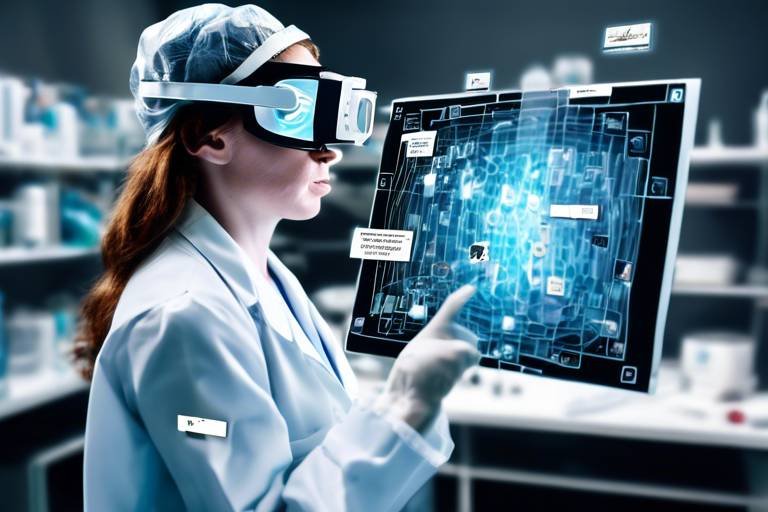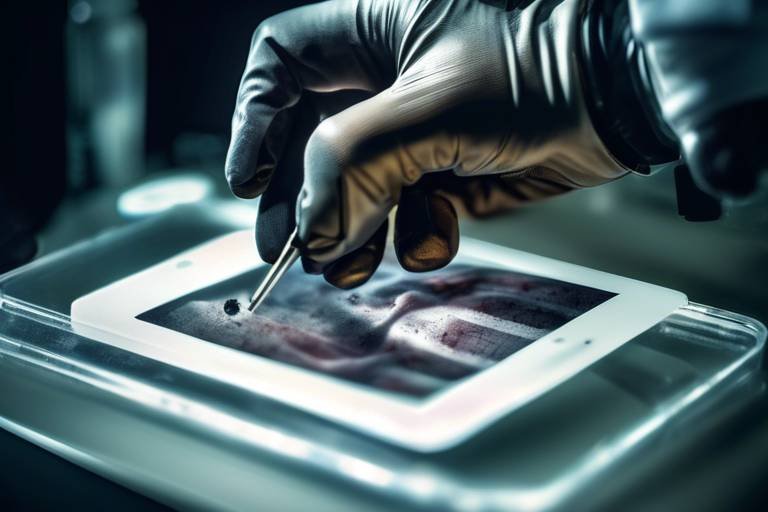How Nanotechnology is Shaping Medicine
In the ever-evolving landscape of modern medicine, nanotechnology is emerging as a game-changer, revolutionizing the way we diagnose, treat, and manage diseases. Imagine a world where medical interventions are not just effective but also tailored to the individual needs of patients. This isn’t science fiction; it’s the promise of nanotechnology! By manipulating matter at the nanoscale, researchers are unlocking new possibilities that were once thought impossible. From targeted drug delivery systems to advanced imaging techniques, the impact of nanotechnology on healthcare is profound and far-reaching.
At its core, nanotechnology involves the manipulation of materials on an atomic or molecular scale, typically within the range of 1 to 100 nanometers. To put that in perspective, a nanometer is one-billionth of a meter! This tiny scale allows scientists to create materials with unique properties that can be harnessed for various applications, particularly in medicine. The significance of nanotechnology in healthcare lies in its ability to enhance the effectiveness of treatments while minimizing side effects. By leveraging the properties of nanoparticles, researchers can improve drug solubility, stability, and bioavailability, leading to better therapeutic outcomes.
One of the most exciting applications of nanotechnology in medicine is its role in drug delivery systems. Traditional drug delivery methods often struggle with issues like poor bioavailability and systemic side effects. However, with the advent of nanoparticles, medications can be delivered more effectively to specific sites in the body. This targeted approach not only enhances the therapeutic effect but also reduces the risk of adverse reactions.
Nano-carriers are specialized vehicles designed to transport therapeutics directly to diseased cells. These tiny carriers can be engineered to recognize and bind to specific types of cells, such as cancer cells, ensuring that the drug is released precisely where it is needed. There are various types of nano-carriers, each with its unique advantages:
- Lipid-based Nanoparticles: These are composed of lipids and are particularly promising for drug delivery due to their biocompatibility and ability to encapsulate both hydrophilic and hydrophobic drugs.
- Polymeric Nanoparticles: Made from biodegradable polymers, these nanoparticles offer versatile drug delivery options, allowing for controlled release and improved therapeutic outcomes.
Lipid-based nanoparticles have garnered significant attention in the field of drug delivery. Their biocompatibility makes them suitable for delivering anti-cancer drugs, ensuring that the body does not reject them. Additionally, they can enhance the solubility of poorly soluble drugs, making it easier for the body to absorb and utilize these medications effectively.
On the other hand, polymeric nanoparticles are known for their versatility. They can be tailored to control the release rate of drugs, which is crucial for maintaining therapeutic levels in the bloodstream. By adjusting the formulation of these nanoparticles, researchers can create drug delivery systems that respond to specific stimuli, such as changes in pH or temperature, further enhancing their efficacy.
Nanotechnology is also making waves in the field of medical imaging. By improving imaging modalities like MRI and CT scans, nanoparticles can provide more precise diagnostics, enabling healthcare professionals to detect diseases at earlier stages. For instance, certain nanoparticles can enhance the contrast in imaging studies, allowing for clearer visualization of tumors or other abnormalities. This advancement not only aids in accurate diagnosis but also assists in monitoring treatment responses.
Despite its immense potential, the integration of nanotechnology into medicine is not without challenges. One of the primary hurdles is navigating the complex regulatory landscape. As nanomedicine continues to evolve, there is a pressing need for updated guidelines that ensure the safety and efficacy of these innovative treatments. Furthermore, understanding the safety profile of nanomaterials is crucial. Potential toxicity issues must be thoroughly investigated before clinical applications can be considered.
The regulatory framework surrounding nanomedicine is intricate and often lagging behind technological advancements. Current regulations may not adequately address the unique properties of nanomaterials, necessitating a reevaluation of existing guidelines to ensure patient safety.
Moreover, the potential toxicity of nanomaterials is a significant concern. Research must focus on understanding how these materials interact with biological systems, as well as their long-term effects on human health. Thorough testing and evaluation are essential before these technologies can be widely adopted in clinical settings.
As we look to the future, the prospects for nanotechnology in medicine are incredibly promising. Ongoing research is paving the way for innovative solutions that could redefine patient care. With advancements in nanomaterials and their applications, we may soon witness breakthroughs in areas such as personalized medicine, where treatments are tailored specifically to the genetic makeup of individual patients. This level of customization could lead to more effective therapies with fewer side effects, ultimately improving patient outcomes.
- What is nanotechnology? Nanotechnology is the manipulation of matter at the nanoscale, typically between 1 to 100 nanometers, allowing for innovative applications in various fields, including medicine.
- How does nanotechnology improve drug delivery? By using nanoparticles, drugs can be delivered more effectively to specific sites in the body, improving bioavailability and minimizing side effects.
- What are the challenges of using nanotechnology in medicine? Key challenges include regulatory hurdles, safety and toxicity concerns, and the need for thorough testing before clinical application.

Understanding Nanotechnology
Nanotechnology is a fascinating field that revolves around the manipulation of matter at an incredibly small scale—typically between 1 and 100 nanometers. To put that into perspective, a nanometer is one-billionth of a meter! Imagine a strand of human hair, which is about 80,000 to 100,000 nanometers wide. This minuscule scale opens up a world of possibilities in various fields, especially in medicine. The ability to engineer materials at the nanoscale allows scientists and researchers to create innovative solutions that can revolutionize how we diagnose and treat diseases.
At its core, nanotechnology leverages the unique properties that materials exhibit at the nanoscale. These properties can differ significantly from those of the same materials at a larger scale. For instance, gold nanoparticles appear red or purple instead of gold, and they have enhanced chemical reactivity. This phenomenon occurs due to the increased surface area-to-volume ratio at the nanoscale, which can lead to improved performance in various applications.
In medicine, nanotechnology is making waves in several areas:
- Drug delivery systems: Nanoparticles can be engineered to deliver drugs directly to targeted cells, increasing the efficacy of treatments while minimizing side effects.
- Diagnostic imaging: Nanotechnology enhances imaging techniques, allowing for earlier and more accurate detection of diseases.
- Tissue engineering: Nanomaterials can be used to create scaffolds that support tissue regeneration, paving the way for advanced therapies.
One of the most exciting aspects of nanotechnology in medicine is its potential to personalize treatments. By tailoring therapies to the individual patient’s needs, healthcare providers can significantly improve outcomes. This shift from a one-size-fits-all approach to a more customized strategy is akin to moving from a generic dish to a gourmet meal prepared specifically for your taste buds—deliciously effective!
As we delve deeper into the world of nanotechnology, it becomes clear that its significance in medicine is not just a passing trend; it represents a paradigm shift in how we approach healthcare. The integration of nanotechnology into medical practice is not without its challenges, but the potential benefits are immense. From enhancing drug delivery to revolutionizing diagnostic techniques, the possibilities are endless!

Applications in Drug Delivery
Nanotechnology is revolutionizing the way we approach drug delivery in medicine. Imagine being able to send tiny, microscopic vehicles directly to the site of a disease, delivering medication precisely where it’s needed without affecting healthy tissues. This is not just a dream; it’s a reality made possible through the use of nanoparticles. These tiny particles, typically ranging from 1 to 100 nanometers, enhance the bioavailability of drugs, ensuring that more of the active ingredient reaches its intended target. This is particularly crucial for treatments like chemotherapy, where traditional methods often result in significant side effects due to the non-targeted nature of drug distribution.
One of the most exciting aspects of nanotechnology in drug delivery is its ability to improve the targeting of therapeutics. By modifying the surface properties of nanoparticles, researchers can design them to recognize and bind to specific disease markers on the surface of cells. This specificity not only increases the effectiveness of the drug but also minimizes the potential for adverse effects. For instance, in cancer treatment, nanoparticles can be engineered to target tumor cells, sparing healthy cells from the harsh effects of chemotherapy.
To better understand how these nano-carriers work, let’s delve into a few types of nanoparticles that are making waves in targeted therapy:
- Lipid-based Nanoparticles: These are composed of lipids and are particularly effective due to their biocompatibility. They can encapsulate both hydrophilic and hydrophobic drugs, making them versatile in treating various conditions.
- Polymeric Nanoparticles: Made from biodegradable polymers, these nanoparticles can be tailored for controlled drug release, ensuring that the therapeutic effect is sustained over time.
Both lipid-based and polymeric nanoparticles are paving the way for innovative cancer therapies, enhancing the overall treatment experience for patients. For instance, lipid-based nanoparticles can deliver anti-cancer drugs like doxorubicin more efficiently, resulting in higher concentrations of the drug at the tumor site while reducing systemic toxicity. On the other hand, polymeric nanoparticles can be engineered to release their payload in a controlled manner, allowing for prolonged therapeutic effects and improved patient compliance.
In addition to these carriers, nanotechnology is also enabling the development of smart drug delivery systems. These systems can respond to specific stimuli, such as pH changes or temperature fluctuations, releasing their therapeutic agents only when they reach the targeted area. This level of precision is akin to having a delivery service that only drops off packages when the recipient is home, ensuring that the medicine is utilized effectively.
Overall, the applications of nanotechnology in drug delivery are vast and varied, offering a glimpse into a future where treatments are more effective, personalized, and less harmful. As research continues to evolve, we can expect even more innovative solutions that will transform patient care and improve health outcomes dramatically.

Nano-carriers for Targeted Therapy
When we think about the future of medicine, nano-carriers stand out as revolutionary tools that are reshaping how we approach targeted therapy. Imagine tiny delivery trucks, so small that you can't see them with the naked eye, transporting powerful medications directly to the disease site in our bodies. This is precisely what nano-carriers do! They are designed to encapsulate therapeutic agents and deliver them to specific cells, particularly in the case of cancer, where precision is paramount.
One of the most exciting aspects of nano-carriers is their ability to improve the effectiveness of drugs while minimizing side effects. Traditional drug delivery methods often result in systemic exposure, which can lead to unwanted side effects. However, with nano-carriers, we can achieve a more targeted approach. These carriers can be engineered to recognize and bind to specific markers on the surface of diseased cells, ensuring that the drug is released precisely where it's needed most.
There are several types of nano-carriers being explored for targeted therapy, each with unique properties and advantages. Below are some of the prominent types and their roles in enhancing treatment efficacy:
- Lipid-based Nanoparticles: These are formed from lipids and are particularly advantageous due to their biocompatibility and ability to encapsulate both hydrophilic and hydrophobic drugs. They can improve the solubility of poorly soluble drugs and enhance their bioavailability.
- Polymeric Nanoparticles: Made from natural or synthetic polymers, these nanoparticles are versatile and can be tailored to control the release of drugs over time. They can also be designed to respond to specific stimuli, such as pH or temperature, allowing for targeted release in the tumor microenvironment.
- Inorganic Nanoparticles: These include metal-based nanoparticles like gold or silica, which can provide unique optical properties for imaging while also serving as drug carriers.
The potential of nano-carriers doesn't stop at just drug delivery. They also play a crucial role in enhancing the therapeutic outcomes of existing treatments. For instance, by utilizing these carriers, doctors can administer lower doses of drugs, reducing toxicity and improving patient compliance. Furthermore, the versatility of nano-carriers allows for the combination of multiple drugs in a single delivery system, a method known as combination therapy. This approach can target multiple pathways in cancer cells, making treatments more effective.
However, it’s essential to acknowledge that while the potential is enormous, the field of nano-carriers for targeted therapy is still evolving. Ongoing research is focused on optimizing these carriers for maximum efficacy and safety. Scientists are working tirelessly to understand how these tiny particles interact within the body, how they can be manufactured at scale, and what regulatory hurdles need to be overcome before they can become mainstream in clinical settings.
In conclusion, nano-carriers are not just a fleeting trend; they represent a significant leap forward in the quest for more effective and safer therapies. As we continue to unravel the complexities of nanotechnology, we can expect to see even more innovative applications that will change the landscape of medicine as we know it.
- What are nano-carriers? Nano-carriers are tiny particles designed to transport therapeutic agents directly to targeted cells, improving the effectiveness of treatments while minimizing side effects.
- How do nano-carriers work? They encapsulate drugs and can be engineered to recognize specific markers on diseased cells, ensuring that the drug is released precisely where it's needed.
- What types of nano-carriers are there? The main types include lipid-based nanoparticles, polymeric nanoparticles, and inorganic nanoparticles, each with unique properties and advantages.
- Are there any risks associated with nano-carriers? While they show great promise, ongoing research is necessary to fully understand their safety profile and potential toxicity before widespread clinical use.

Lipid-based Nanoparticles
Lipid-based nanoparticles (LNPs) have emerged as a revolutionary tool in the field of drug delivery, particularly in the realm of oncology. These tiny carriers, often in the range of 1 to 100 nanometers, are composed primarily of lipids, which are naturally occurring fats. This biocompatibility is one of the key reasons why LNPs are gaining traction in the medical community. Imagine being able to deliver a potent medication directly to a tumor while minimizing side effects on healthy tissues—this is precisely what lipid-based nanoparticles aim to achieve.
One of the standout features of LNPs is their ability to encapsulate both hydrophilic and hydrophobic drugs, making them incredibly versatile. This capability allows for a tailored approach to drug delivery, ensuring that the therapeutic agent reaches its target in a controlled manner. For instance, when treating cancer, traditional methods often lead to systemic toxicity, but with LNPs, the drug can be released in a sustained manner, significantly enhancing the therapeutic index.
Another significant advantage of lipid-based nanoparticles is their ability to improve the solubility and stability of poorly water-soluble drugs. Many promising anti-cancer agents fail in clinical trials due to their low solubility, but LNPs can help overcome this barrier. By encapsulating these drugs, LNPs enhance their bioavailability, allowing for lower dosages and reduced side effects. This is akin to upgrading from a standard car to a high-performance vehicle; the latter not only gets you to your destination faster but does so more efficiently.
Moreover, LNPs can be engineered to include targeting ligands on their surface. These ligands can recognize and bind to specific receptors on cancer cells, ensuring that the drug payload is released precisely where it's needed. This targeted approach is a game changer, as it not only maximizes the efficacy of the treatment but also minimizes the impact on healthy cells, which is a common drawback of conventional therapies.
Here's a brief overview of the advantages of lipid-based nanoparticles:
- Biocompatibility: Made from natural lipids, they are generally well-tolerated by the body.
- Versatile Drug Encapsulation: Capable of delivering a wide range of therapeutic agents.
- Enhanced Stability: Protects drugs from degradation in the bloodstream.
- Targeted Delivery: Can be modified to specifically target diseased cells.
In summary, lipid-based nanoparticles represent a significant advancement in drug delivery systems. Their unique properties allow for the effective transport of therapeutics directly to the site of action, minimizing systemic exposure and enhancing overall treatment outcomes. As research continues to evolve, we can expect to see even more innovative applications of LNPs in the fight against cancer and other diseases.
What are lipid-based nanoparticles?
Lipid-based nanoparticles are tiny carriers made primarily of lipids that encapsulate drugs and deliver them directly to targeted sites in the body, enhancing the effectiveness of therapies.
How do lipid-based nanoparticles improve drug delivery?
They improve drug delivery by increasing the solubility and stability of drugs, providing controlled release, and enabling targeted delivery to specific cells, particularly in cancer treatment.
Are lipid-based nanoparticles safe?
Yes, lipid-based nanoparticles are generally considered safe due to their biocompatibility, but thorough testing is necessary to assess their safety profile in clinical applications.
What types of drugs can be delivered using lipid-based nanoparticles?
Lipid-based nanoparticles can deliver a wide range of drugs, including hydrophilic and hydrophobic compounds, making them versatile for various therapeutic applications.

Polymeric Nanoparticles
Polymeric nanoparticles have emerged as a revolutionary approach in the field of drug delivery, offering a plethora of advantages that traditional methods simply cannot match. These tiny particles, typically ranging from 1 to 1000 nanometers in size, are composed of biocompatible and biodegradable polymers, making them an ideal choice for transporting therapeutics directly to the target site in the body. Imagine them as tiny delivery trucks, engineered to navigate through the complex roads of the human body, ensuring that the medication reaches its destination without getting lost along the way.
One of the standout features of polymeric nanoparticles is their versatility. They can be tailored to encapsulate a wide variety of drugs, including hydrophilic and hydrophobic compounds. This adaptability means that researchers can design nanoparticles to meet specific therapeutic needs, enhancing the effectiveness of treatments. For instance, by adjusting the polymer composition and the method of preparation, scientists can control the release rate of the drug, ensuring that it is delivered in a sustained manner over time. This is akin to having a slow-release pill that gradually dispenses medication rather than a quick burst that might not be as effective.
Moreover, polymeric nanoparticles can be engineered to improve drug solubility and stability, which are critical factors in ensuring that the medication remains effective until it reaches the target cells. The encapsulation of drugs within these nanoparticles not only protects them from degradation but also increases their bioavailability, allowing for lower doses to achieve the desired therapeutic effect. This is particularly beneficial in cancer therapy, where high doses of drugs can lead to severe side effects. By using polymeric nanoparticles, clinicians can minimize toxicity while maximizing treatment efficacy.
Another significant advantage of polymeric nanoparticles is their ability to facilitate targeted therapy. By attaching specific ligands or antibodies to the surface of the nanoparticles, researchers can create a "homing" mechanism that directs the drug precisely to the diseased cells, such as cancer cells. This targeted approach reduces the impact on healthy tissues and enhances the overall effectiveness of the treatment. It's like having a guided missile that knows exactly where to strike, minimizing collateral damage.
In terms of formulation, polymeric nanoparticles can be produced through various techniques, including solvent evaporation, nanoprecipitation, and emulsion methods. Each technique offers unique benefits and can be chosen based on the properties of the drug being delivered. The flexibility in manufacturing also allows for large-scale production, which is essential for clinical applications.
Despite their remarkable potential, it’s essential to consider the challenges associated with polymeric nanoparticles. Issues such as scalability, stability during storage, and the need for comprehensive toxicity assessments remain areas of active research. However, as technology advances and our understanding of these nanoparticles deepens, the future looks bright for their application in medicine.
In summary, polymeric nanoparticles represent a promising frontier in drug delivery systems, combining versatility, targeted action, and enhanced therapeutic outcomes. As we continue to explore their capabilities, it’s clear that they hold the key to unlocking more effective treatments for a variety of diseases, particularly in the realm of oncology.
- What are polymeric nanoparticles?
Polymeric nanoparticles are tiny particles made from biocompatible and biodegradable polymers, designed to deliver drugs directly to target sites in the body.
- How do polymeric nanoparticles improve drug delivery?
They enhance drug solubility, stability, and bioavailability while allowing for controlled release and targeted therapy, reducing side effects and improving treatment effectiveness.
- What types of drugs can be delivered using polymeric nanoparticles?
Polymeric nanoparticles can encapsulate a wide range of drugs, including both hydrophilic and hydrophobic compounds, making them versatile for various therapeutic applications.
- Are there any risks associated with polymeric nanoparticles?
While they offer many benefits, challenges such as potential toxicity, stability issues, and the need for regulatory approvals must be addressed before widespread clinical use.

Enhancing Imaging Techniques
In the realm of modern medicine, the ability to visualize the inner workings of the human body has always been a game-changer. Imagine being able to pinpoint a problem without invasive procedures, simply by looking at detailed images of organs and tissues. This is where nanotechnology steps in, revolutionizing imaging techniques and taking diagnostics to a whole new level. By utilizing nanoparticles, healthcare professionals can achieve unprecedented precision in identifying diseases, particularly in the early stages when treatment is most effective.
One of the standout features of nanoparticles is their ability to enhance the contrast in imaging modalities such as Magnetic Resonance Imaging (MRI) and Computed Tomography (CT) scans. Traditionally, these imaging techniques have relied on contrast agents that may not always provide the clarity needed for accurate diagnosis. However, with the integration of nanotechnology, the contrast agents can be tailored at the nanoscale, improving their effectiveness and safety.
For instance, consider how superparamagnetic nanoparticles can be used in MRI. These tiny particles can significantly increase the contrast between healthy and diseased tissues, allowing doctors to spot tumors or abnormalities that might otherwise go unnoticed. Additionally, their small size means they can navigate through the bloodstream more easily, reaching areas that larger particles cannot. This capability not only enhances the quality of the images produced but also reduces the amount of contrast agent needed, minimizing potential side effects for patients.
Moreover, nanoparticles can be designed to bind specifically to certain types of cells, such as cancer cells. This specificity allows for a more targeted approach in imaging, where doctors can visualize the exact location of tumors or other pathological changes in real-time. Imagine being able to see a tumor highlighted against healthy tissue, making it easier for surgeons to plan their approach. This level of detail is not just beneficial; it's crucial for successful outcomes in complex surgeries.
To illustrate the impact of nanotechnology on imaging, consider the following
| Imaging Modality | Traditional Contrast Agents | Nanoparticle-enhanced Agents |
|---|---|---|
| MRI | Limited contrast, potential side effects | Improved contrast, reduced side effects |
| CT Scans | Higher doses required for clarity | Lower doses, better visualization |
| Ultrasound | Basic imaging | Enhanced imaging with targeted nanoparticles |
This table highlights the significant advantages that nanoparticle-enhanced imaging agents hold over traditional options, showcasing their potential to improve diagnostic accuracy and patient safety. However, while the benefits are clear, it’s essential to acknowledge that the integration of nanotechnology into imaging is still in its developmental stages. Researchers are continually exploring new materials and techniques to optimize these applications further.
In conclusion, the fusion of nanotechnology with imaging techniques is paving the way for a future where diseases can be detected earlier and more accurately than ever before. As this field continues to evolve, we can expect to see even more innovative solutions that will not only enhance the quality of medical imaging but also improve patient outcomes significantly. The journey of nanotechnology in medicine is just beginning, and the possibilities are as vast as they are exciting.

Challenges and Limitations
While the potential of nanotechnology in medicine is enormous, it is not without its challenges and limitations. As we delve deeper into this exciting frontier, we encounter a myriad of obstacles that researchers and practitioners must navigate. One of the most pressing issues is the regulatory framework surrounding nanomedicine. The current regulations often lag behind the rapid advancements in technology, creating a complex landscape that can be daunting for innovators. The necessity for updated guidelines is clear; without them, the path to market for new nanomedicine products can be fraught with delays, uncertainty, and increased costs.
Moreover, the safety and toxicity concerns associated with nanomaterials cannot be overlooked. Understanding how these tiny particles interact with biological systems is crucial. For instance, the very properties that make nanoparticles effective in drug delivery—such as their small size and high reactivity—can also pose risks. Potential toxicity issues may arise from the accumulation of nanoparticles in organs or tissues, leading to unforeseen health impacts. Therefore, comprehensive testing and evaluation of these materials are essential before they can be safely applied in clinical settings.
To better understand the regulatory and safety landscape, let’s take a closer look at the current challenges:
| Challenge | Description |
|---|---|
| Regulatory Framework | Outdated regulations hinder the approval process for nanomedicine products, making it difficult for innovations to reach patients. |
| Safety Concerns | Potential toxicity and side effects of nanoparticles require extensive research and testing to ensure patient safety. |
| Public Perception | Misinformation and lack of understanding about nanotechnology can lead to skepticism and resistance from the public. |
Additionally, public perception plays a significant role in the adoption of nanotechnology in medicine. Misinformation and fear surrounding the unknown can lead to skepticism among patients and healthcare providers alike. It’s vital for the scientific community to engage in effective communication strategies to educate the public about the benefits and safety of nanotechnology. Transparency in research and development processes can foster trust and acceptance, paving the way for broader implementation.
In summary, while the promise of nanotechnology in medicine is undeniably exciting, navigating the challenges of regulatory frameworks, safety concerns, and public perception is essential for its successful integration into healthcare. Ongoing research and proactive measures will be key in addressing these limitations, ensuring that the transformative potential of nanotechnology can be fully realized.
- What is nanotechnology in medicine? Nanotechnology in medicine refers to the use of tiny materials, typically at the nanoscale, to improve various medical applications, including drug delivery and imaging techniques.
- What are the main challenges facing nanotechnology in medicine? The main challenges include regulatory hurdles, safety and toxicity concerns, and public perception issues.
- How can public perception be improved regarding nanotechnology? Effective communication and educational outreach can help demystify nanotechnology and build public trust in its safety and efficacy.

Regulatory Framework
When it comes to the integration of nanotechnology in medicine, the regulatory framework is a crucial aspect that cannot be overlooked. The complexity of nanomedicine poses unique challenges for regulatory authorities. Unlike traditional pharmaceuticals, nanomedicines are often composed of materials at a scale that can behave very differently in biological systems. This necessitates a comprehensive understanding of their properties and potential effects on human health.
Currently, regulatory bodies such as the U.S. Food and Drug Administration (FDA) and the European Medicines Agency (EMA) are working to establish guidelines specifically tailored for nanotechnology applications. These organizations are tasked with ensuring that any new nanomedicine is both safe and effective before it reaches the market. However, the existing regulatory guidelines are often seen as outdated, as they do not adequately address the unique characteristics and risks associated with nanomaterials.
One of the key issues in the regulatory framework is the definition of nanomaterials. Different jurisdictions may have varying definitions, which can lead to inconsistencies in the approval process. For example, the FDA defines nanotechnology based on the size of the particles, while the EMA may focus on the intended use and the specific properties that arise at the nanoscale. This lack of a unified definition can create confusion and delays in bringing innovative therapies to patients.
Moreover, there is a pressing need for updated guidelines that specifically address the following aspects:
- Characterization of Nanomaterials: Comprehensive testing to understand the physical and chemical properties of nanomaterials is essential.
- Safety Assessments: Rigorous testing protocols to evaluate the safety and potential toxicity of nanoparticles are crucial for public health.
- Post-Market Surveillance: Continuous monitoring of nanomedicines after they are on the market to assess long-term effects and efficacy.
Additionally, collaboration between regulatory bodies, researchers, and industry stakeholders is vital. By fostering open communication and sharing knowledge, these parties can work together to develop a regulatory framework that not only protects patients but also encourages innovation. As the field of nanotechnology continues to evolve, it is imperative that the regulatory landscape keeps pace, ensuring that cutting-edge therapies can be safely and effectively delivered to those in need.
In conclusion, while the regulatory framework for nanomedicine is still in its infancy, the ongoing dialogue among stakeholders offers hope for a more streamlined process in the future. By addressing the challenges and adapting to the unique aspects of nanotechnology, we can pave the way for groundbreaking advancements in medical treatments.
- What is nanotechnology? Nanotechnology involves manipulating matter at the nanoscale, enabling innovations across various fields, particularly in medicine.
- Why is the regulatory framework for nanomedicine important? It ensures that nanomedicines are safe and effective before they reach the market, protecting public health.
- What challenges exist in regulating nanotechnology? Key challenges include inconsistent definitions of nanomaterials, outdated guidelines, and the need for comprehensive safety assessments.
- How can stakeholders improve the regulatory process? By fostering collaboration and open communication among regulatory bodies, researchers, and the industry, stakeholders can create a more effective framework.

Safety and Toxicity Concerns
As exciting as the advancements in nanotechnology are, they come with a set of serious safety and toxicity concerns that cannot be overlooked. The very properties that make nanoparticles so effective in medicine—such as their small size and large surface area—can also lead to unforeseen complications. For instance, when these tiny particles enter the human body, they can interact with biological systems in ways that are not yet fully understood. This raises important questions about their long-term safety and potential side effects.
One of the primary concerns is the toxicity of nanoparticles. Different materials used to create nanoparticles, such as metals or polymers, can exhibit varying levels of toxicity. For example, some metal nanoparticles have been shown to induce oxidative stress in cells, leading to cellular damage. Additionally, the route of exposure plays a crucial role in determining toxicity. Inhalation, ingestion, or dermal exposure can result in different biological responses, making it essential to assess the safety of nanoparticles based on their intended use.
Moreover, the size and shape of nanoparticles can influence their behavior in biological systems. Smaller nanoparticles may penetrate cell membranes more easily, but they could also distribute throughout the body in unpredictable ways. This unpredictability raises concerns about potential accumulation in organs, which could lead to toxicity over time. For instance, studies have shown that certain nanoparticles can accumulate in the liver and spleen, leading to adverse effects. Understanding the biodistribution of these particles is critical for ensuring their safe application in medicine.
Furthermore, regulatory frameworks for nanomedicine are still evolving. The current regulations often lag behind technological advancements, creating a gap in safety assessments. Regulatory bodies need to establish clear guidelines for the evaluation of nanomaterials used in medical applications. This includes understanding their interactions with biological systems, potential side effects, and long-term impacts on human health.
In summary, while nanotechnology holds great promise for revolutionizing medicine, it is vital to address the safety and toxicity concerns associated with its use. Ongoing research is essential to uncover the potential risks and develop strategies to mitigate them. Only by ensuring the safety of these innovative materials can we fully harness their potential to improve patient care.
- What are nanoparticles?
Nanoparticles are tiny particles that measure between 1 and 100 nanometers in size. They have unique properties that make them useful in various fields, including medicine.
- Why are safety concerns associated with nanoparticles?
The small size and large surface area of nanoparticles can lead to unpredictable interactions with biological systems, raising potential toxicity and safety issues.
- How are regulatory frameworks addressing nanotechnology?
Regulatory bodies are working to establish guidelines for the safe use of nanomaterials in medicine, but the process is ongoing and needs further development.
- What steps are being taken to ensure the safety of nanomedicine?
Researchers are conducting extensive studies to understand the toxicity, biodistribution, and long-term effects of nanoparticles to ensure their safe application in medical treatments.

The Future of Nanotechnology in Medicine
The future of nanotechnology in medicine is not just a glimpse of what could be; it's a vibrant landscape of possibilities that are already beginning to unfold. As researchers dive deeper into the nanoscale world, they are uncovering innovative solutions that promise to revolutionize diagnosis, treatment, and patient care. Imagine a world where diseases are detected at their inception, where therapies are tailored to the individual at a molecular level, and where recovery times are significantly reduced. This is not science fiction; this is the future that nanotechnology is paving the way for.
One of the most exciting prospects is the development of smart nanoparticles. These tiny carriers can be programmed to respond to specific biological signals, enabling them to release their therapeutic payload precisely when and where it is needed. For instance, in cancer treatment, these nanoparticles can be designed to recognize and bind to cancer cells, delivering chemotherapy directly to the tumor while sparing healthy tissue. This targeted approach not only enhances the effectiveness of the treatment but also minimizes side effects, making the patient’s journey much more bearable.
Moreover, the integration of nanotechnology with personalized medicine is set to change the game entirely. By analyzing an individual’s genetic makeup, healthcare providers can develop customized treatment plans that are tailored to the unique characteristics of each patient. This means that treatments can be more effective and have a higher success rate, as they are designed to work with the patient’s specific biology rather than a one-size-fits-all approach.
As we look ahead, the potential for nanobots—tiny robots that can navigate through the body to perform medical tasks—cannot be overlooked. These microscopic machines could be used for a variety of applications, from repairing damaged tissues to delivering drugs directly to the site of an infection. Imagine a scenario where a nanobot could enter the bloodstream, identify a rogue cancer cell, and deliver a targeted treatment without harming surrounding healthy cells. The implications are staggering!
However, with great potential comes great responsibility. The path forward is not without challenges. For nanotechnology to reach its full potential in medicine, we must address several key issues. First and foremost, the regulatory landscape must evolve to keep pace with the rapid advancements in nanomedicine. Regulatory bodies need to create updated guidelines that ensure the safety and efficacy of nanomaterials used in clinical settings.
Additionally, the safety and toxicity concerns surrounding nanomaterials cannot be ignored. Researchers must conduct thorough testing to understand the long-term effects of these materials on human health and the environment. Only through rigorous research and transparent communication can we build public trust in these groundbreaking technologies.
In conclusion, the future of nanotechnology in medicine is bright and filled with promise. As we continue to explore the nanoscale realm, we can anticipate a wave of innovations that will not only enhance our understanding of diseases but also transform the way we treat them. The journey is just beginning, and the possibilities are endless.
- What is nanotechnology? - Nanotechnology is the manipulation of matter at the nanoscale, typically between 1 and 100 nanometers, allowing for advancements in various fields, including medicine.
- How does nanotechnology improve drug delivery? - Nanotechnology enhances drug delivery by using nanoparticles that can target specific cells, improving bioavailability and reducing side effects.
- What are smart nanoparticles? - Smart nanoparticles are engineered to respond to specific biological signals, allowing for controlled drug release at targeted sites in the body.
- What are the challenges facing nanotechnology in medicine? - Key challenges include regulatory hurdles, safety and toxicity concerns, and the need for thorough testing before clinical application.
Frequently Asked Questions
- What is nanotechnology in medicine?
Nanotechnology in medicine refers to the manipulation of matter on a nanoscale to create materials and devices that can improve healthcare. It allows for innovations in drug delivery, diagnostics, and imaging, ultimately enhancing patient care.
- How does nanotechnology improve drug delivery?
Nanotechnology enhances drug delivery by using nanoparticles that can target specific cells or tissues in the body. This targeted approach increases the bioavailability of drugs, ensuring they are more effective and reducing side effects.
- What are nano-carriers?
Nano-carriers are tiny vehicles designed to transport therapeutic agents directly to diseased cells. They can be made from various materials, including lipids and polymers, and play a crucial role in targeted cancer therapy.
- What are lipid-based nanoparticles?
Lipid-based nanoparticles are a type of nano-carrier known for their biocompatibility. They are particularly effective in delivering anti-cancer drugs, as they can encapsulate the drugs and release them at the targeted site, improving treatment outcomes.
- What are the challenges associated with nanotechnology in medicine?
Despite its potential, nanotechnology faces several challenges, including regulatory hurdles and safety concerns. The need for updated guidelines and thorough testing is essential to ensure the safety and efficacy of nanomedicine.
- How is the regulatory framework for nanomedicine structured?
The regulatory landscape for nanomedicine is complex and varies by region. Current regulations often do not specifically address nanomaterials, highlighting the need for updated guidelines to ensure the safe use of these technologies in clinical settings.
- Are there safety concerns regarding nanomaterials?
Yes, understanding the safety profile of nanomaterials is crucial. Potential toxicity issues must be thoroughly investigated through extensive testing before these materials can be used in clinical applications.
- What does the future hold for nanotechnology in medicine?
The future of nanotechnology in medicine is bright, with ongoing research leading to exciting innovations. Emerging trends and potential breakthroughs could revolutionize diagnosis, treatment, and patient care in the coming years.


















